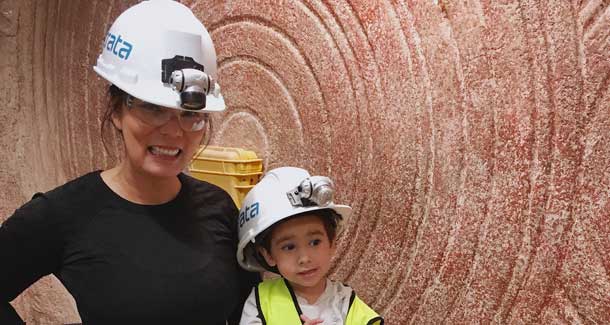Natasha Dreaver, Engineer-in-Training with her daughter Asten at the Nutrien Wonderhub in Saskatoon.
Natasha Dreaver’s story is one of perseverance. She didn’t have a lot as a young child growing up in Prince Albert. Life gave her all she could handle. Not only did she handle each challenge, but she carved a life and a career that could serve as a prime example to youth that hard work does pay off.
First in Her Family
Dreaver, Engineer-in-Training, originally is from Mistawasis First Nation. She is the first of 24 grandchildren in her family to attend and graduate from post-secondary school. She put an exclamation point on the achievement by earning two degrees — a B.Sc. in biological sciences from the University of Alberta and later earned a B.Sc. in chemical engineering from the University of Saskatchewan.
Her parents weren’t there to see her graduate – they both passed away early in her educational pursuits. Dreaver discontinued her education at the U of A after her mother passed to move home to Prince Albert to raise her younger brother, who was in high school at the time.
“That really motivated me. I knew I had to get a good education in order to get a good job,” said Dreaver, who is now a process engineer, surface mill operations at the Mosaic Colonsay mine.
“Even if it was something like catching a cab to get to the grocery store or receiving a Christmas hamper … it’s a lot different than the stories I hear from my colleagues. Their parents might have been geologists or engineers. My background is quite a bit different.”
Dreaver assumed more of a parental role after her parents passed. The loss deeply affected her brother, and while she was there for emotional stability and support, Dreaver’s other responsibilities included paying the bills and putting food on the table.
She put her biological sciences degree to good use and found work at the Saskatchewan Forestry Centre and later at the First Nations Agriculture Council of Saskatchewan in Saskatoon, where she orchestrated youth programs around First Nations and agriculture.
She worked there for almost two years, which put her in a better financial state before she eventually enrolled at the U of S and earned her second degree, this one in chemical engineering.
Her first job in the industry was at Cameco’s Cigar Lake uranium mine, before she started work with Mosaic.
Mosaic has put significant attention on Indigenous inclusion in its workforce in the last several years, including Indigenous Cultural Awareness training for every Saskatchewan employee and increasing the percentage of its Indigenous employees to at least 15 per cent by 2025.
Dreaver has maintained her passion in working and mentoring youth.
Dreaver participates in outreach programs every year, including the APEGS Dream Big: Engineering Our World presentation during Engineering and Geoscience Week. She has visited several Indigenous career fairs, as well as her own First Nation for presentations to the entire school student body.
Her message to the youth is simple.
“As much as my background isn’t the greatest background, it is a living reality for a lot of the kids I meet with,” she said.
“If they can see someone who has an interest in math and doesn’t get involved in gangs or drugs or alcohol, that kind of thing, you can definitely succeed.”
“Because one out of 100 might get out and not be a statistic you might see on the news.”
“There are so many more opportunities out there now through inclusion and diversity. There are more available spots targeted specifically for First Nations students at universities.”
The opportunity to constantly learn is a big reason why Dreaver loves her career.
“There are people that I work with who have been here for almost 40 years and they’re still learning new things, especially when we work on new research and development projects,” she said. “I really enjoy that aspect because I’m learning something new. There is so much to know about working in a mine in general – optimizing the process, operating new equipment, effective operational strategies, best practices for safety and environmental aspects and the economics and cost benefits analysis of new business opportunities.”
“Our group has its hands in a lot of different departments and we get to have input or be involved in so many projects. If I was doing the same thing every day it would be tiresome.”
Dreaver and her husband live in Saskatoon where they raise their two children – a six-year-old son and three-year-old daughter.
